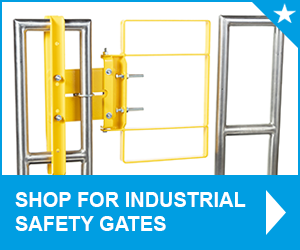
OSHA requirements have always been a complex topic, but OSHA’s Walking-Working Surfaces and Fall Protection Standards may have made things even more complicated for some facilities. This rule updated general safety standards specific to slip, trip and fall hazards. The rule also included a new section that established employer requirements for using personal fall protection systems. The rule’s most significant update was that it allowed employers to choose a fall protection system that works best for them, like safety swing gates.
Where Should Safety Gates be Used?
Ladderways: All ladder access points should be protected with safety gates. Protect your employees from falling into the entrance of a ladderway floor hole with the implementation of a high quality, self-closing safety gate.
Work Platforms: There are a variety of forms of work platforms, but they all have one thing in common: they require fall protection for your workers. Whether they’re standard platforms, mezzanines, or loading docks, protect all unprotected edges of the platform by implementing safety swing gates. Not only will it protect your employees but it will also keep you OSHA compliant.
Protecting Roofing Workers: Safety managers can use guardrail systems around roof openings to protect workers from injury and fall risks. The top rails of a guardrail system need to be 39 to 45 inches higher than the working surface. The guardrail must also be able to withstand a 200-pound force. By using a system of safety gates to complement the guard rails surrounding the open roof area, you are effectively keeping your workers safe and abiding by OSHA compliance.
Any Surface 4 Feet or More: Any work area that is four feet or more in the air must be protected with guardrails and safety gates on all side that are at least 42” tall. These fall protection solutions must be on every open side of the platform.
Safety Statistics to Consider
Falls are one of the most common causes of work-related injuries and deaths. OSHA announced its top 20 most frequent workplace safety violations and fall protection ranked as its top violation with nearly 7,000 citations in 2015.
According to the Bureau of Labor Statistic, deaths from trips, slips and falls increased 10%.
Additionally, these tragic injuries and deaths can cause a considerable financial burden for companies. Worker’s compensation and medical costs that come with occupational fall incidents have been estimated at $70 billion annually in the United States alone.
The statistics show the importance of preventing or at least reducing workplace injuries. Having the right fall protection equipment in place, like industrial safety swing gates, can help prevent these dangerous slips, trips and falls.
OSHA standards require that adequate fall protection be provided for elevations of four feet or more in general workplaces, five feet in shipyards and six feet in construction sites. OSHA also requires that fall protection be provided when working with dangerous equipment and machinery, no matter what the fall distance is.
To best mitigate the risk of employees being injured or even killed from falls, OSHA recommends the use of a safety swing gate to protect your workers. These safety gates are simple to implement and will save you time and money while keeping your employees safe.
You need equipment you can trust and employees need equipment they can count on. To remain OSHA compliant, you need guardrails that meet the above specific strength standards. Luckily, there are safety swing gate options available that can accomplish this for you, giving you one less thing to worry about.
Safety Goals
Here are a few more safety goals your workplace should strive to meet, and implementing a safety swing gate will usually meet all of them. You want:
- Guardrail systems that are smooth-surfaced. This protects employees from punctures, cuts, and prevents clothing from snagging.
- A self-closing gate that slides or swings AWAY from the hole. The gate should also be equipped with a top rail and mid rail.
- Ladder holes protected by a guardrail system to protect each employee from falling.
- Guardrail systems should be capable of withstanding a force of at least 200 pounds applied in a downward or outward direction
Conclusion
Ensuring your workplace is OSHA compliant can be a complex task, especially now with the new rules coming into place. Many safety managers are simplifying the process by using safety swing gates to provide their workers with a safer workplace that employees can count on. It’s not just recommended, it is absolutely required by OSHA.
If you are looking for industrial safety gates that will not only protect your workers but also keep you OSHA compliant, use Fabenco safety gates. Fabenco safety gates are easy to install, fit all handrail types and fulfill all the mentioned OSHA regulations.
Take a look at Fabenco safety swing gates if you want affordable, yet high-quality products that will accomplish all of your OSHA safety compliance requirements.






